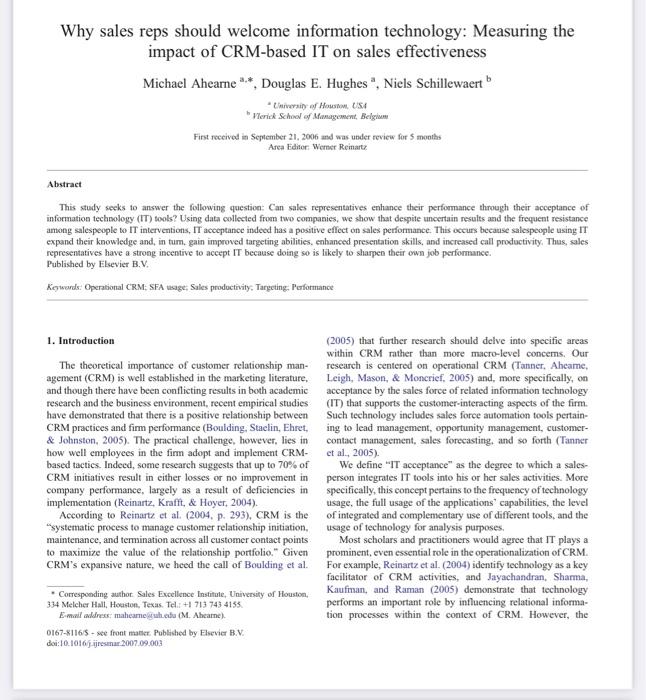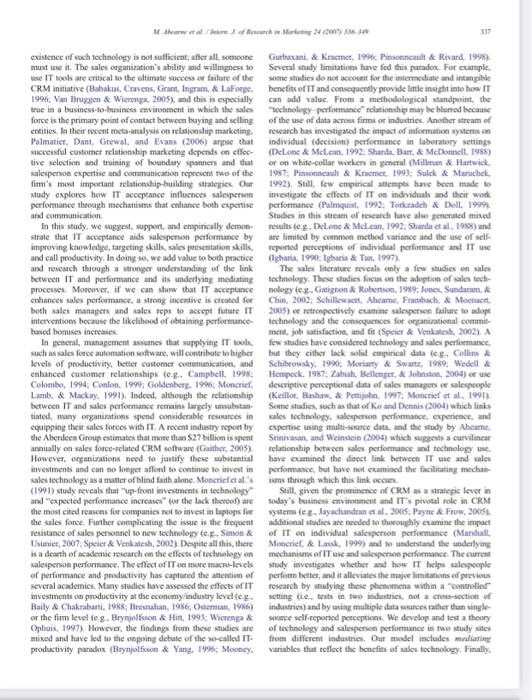Does the title express clearly what the manuscript is about?
Does it highlight the importance of the study?
Is the abstract a short and clear summary of the aims, key methods, important findings and conclusions?
Does it include enough information to stand alone?
Does the introduction clearly summarize the current state of the topic?
Does it clearly explain why the study was necessary?

Why sales reps should welcome information technology: Measuring the impact of CRM-based IT on sales effectiveness Michael Ahearne a,, Douglas E. Hughes a, Niels Schillewaert b " Chrvarain of Houshowi CSi beriek School of Management, Beigmem First roeived in September 21,2006 and was under review for 5 months Area Editor: Womer Reinart Abstract This study seeks to answer the following question: Can sales representatives enhance their performance through their acceptance of information techoology (IT) tools? Using data collected from two companies, we show that decpite uncertain results and the frequent resistance among salespeople to IT intervertions, IT acceptance indecd has a positive effect on sales performance. This occurs because salespeople using II expand their knowledge and, in tum, gain improved targeting abilities, enhanced presentation skills, and increased call productivity, Thus, sales representatives have a strong incentive to aceept IT because doing so is likely to sharpen their own job performance. Published by Elsevier B.V. Keywands: Operational CRM; SEA usage; Sales productivity; Targeting: Porformance 1. Introduction (2005) that further research should delve into specific areas within CRM rather than more macro-level concems. Our The theoretical importance of customer relationship man- research is centered on operational CRM (Tanner, Aheame, agement (CRM) is well established in the marketing literature, Leigh, Mason, \&. Moncrief, 2005) and, more specifically, on and though there have been conflicting results in both academic acceptance by the sales force of related information technology research and the business environment, recent empirical studies. (IT) that supports the customer-interacting aspects of the firm. have demonstrated that there is a positive relationship between Such technology includes sales force automation tools pertainCRM practices and firm performance (Boulding, Staclin, Ehret, ing to lead management, opportunity management, customer\& Johnston, 2005). The practical challenge, however, lies in contact management, sales forecasting, and so forth (Tanner how well employees in the fim adopt and implement CRM- et al. 2005). based tactics. Indeed, some research suggests that up to 70% of We define "IT acceptance" as the degree to which a salesCRM initiatives result in cither losses or no improvement in person integrates IT tools into his or her sales activities. More company performance, largely as a result of deficiencies in specifically, this concept pertains to the frequency of technology implementation (Reinartz. Krafft, \& Hoyer, 2004). usage, the full usage of the applications' capabilities, the level According to Reinart et aL (2004, p. 293), CRM is the of integrated and complementary use of different tools, and the "systematic process to manage customer relationship initiation. usage of technology for analysis purposes. maintenance, and termination across all customer contact points. Most scholars and practitioners would agree that II plays a to maximize the value of the relationship portfolio." Given prominent, even essential role in the operationalization of CRM. CRM's expansive nature, we heed the call of Boulding et al. For example, Reinartz et al. (2004) identify technology as a key facilitator of CRM activities, and Jayachandran, Sharma, - Corresponding author Sales Excellenoe Institute, University of Houston, Kaufman, and Raman (2005) demonstrate that technology 334 Melcher Hall, Hoanton, Texas. Teli +17137434155. performs an important role by influencing relational informaE-mail aldres: maheame(tuhefu (M. Mhearne). tion processes within the context of CRM. However, the 0167-81165 - see front madice Publithed by Elsevier B.V. doi:10.1016fijirsenar 2007.09 .003 existence of sech tochnology is not sufficient; afker all, somoone Gurbaxani, \& Knacmer, 1996c Pinooncant \& Rivard, 1990). must uw it. The sales oqeaniration's ability and willingness to Several study limitations have fed this pamdox. For exarnple. lese IT tools are critical to the eltimate suceess or Ealure of the soene studics do not accocat for the inlermediate and irtangible CRM initiative (Bsbakus, Cravens, Grant, Ingram, \& LaForge. benefits of IT and consequently provide little insight into how II 1996; Vau Brupgen \& Wicrenga, 2005), and this is expecially can add value. From a methodological standpoint. the trve ia a basiness-lo-busibess envigonent in which the sales "technelogy-performance" relationsip may be blurred because force is the primary point of contact between buying and selling of the use of data across firms or industries. Another stream of enities. In their mocent metacatalyxis on telationship natketing. reuearch has investigatod the ingact of information wystems an Polmatier. Dant. Grewal, and Evans (2006) argwe that individual (decision) performance in laboratory settings macessfal customer relationahip marketing depends en efloc- (DeLons \& McLeah, 1992; Shanda, Barr, A. MeDotmell. 1988) tive selection and training of boundary spannens and that of on white-collar woeken in general (Millman &. Hartwick. salesperwoe expertise and communication represent two of the 19s7; Pihswncault \& Kracmet, 1993; Sulck \& Marachek, fim's mol important rhationdip-builling stralegies Oar 1992). Still. few empirical attempts have been made lo study explores how IT accepeance influences salesperwon investigate the effects of IT on individuals and their wodk performance throagh mechanimans that cahance both expertise performanee (Palmquiat, 1992. Torkadch a Doll. 1999) and communication. Studies in this stream ef reseatch have also generated mixed In this study, we suggest, support, and empirically demon- results (c.g. Delone S Mcl.can, 1992; Shanda et al. 1988) and strate that IT aceeptanee aids salspersin petlormance by are lianited by common method variance and the ase of self. improving knoaledge, targeting skills, sales preventation skills, reported percepeions of individual perfotmanoe and II use and call productivity. In doing so, we add value to both practice (Igharia, 1900; Igbaria 5 Ton, 1997). and reseach through a stronger undentanding of the link. The sales literature reveals only a few studies on sales between IT and nerformance and its underlying mediating fechnology. These stadies facas on the adoption of sales lectlprocesses. Moreover, if we can show that IT aceeptance nolegy (e.g. Gatignon \& Robertcon. 1989: Jones, Sundaram, \& enhances sales performanoc, a strong inocntive is creatod fer Chin, 2002; Schillewacr, Ahearne, Frambach, \& Moenact. both sales managen and sales sepu to accept flature IT 2005) e retropectively examine salespersen fxilure to adope intervention because the likelihood of ohtaining performance- lochnology and the consequences fot organirational conamitbuned bonuses increaries. mem, job satisfaction, and fin (Speier of Venlatech, 2002)A In geacral, management asvumes that supplying IT sookk. few stadies bave considered technology and sales performance. such assales fonce automation software, will contribate to higher but they either lack solid empirical data (e.g, Collins \& kvels of productivity, beter customer comenanication, and Schibeowsky, 1990, Moriany 8 Swartz, 1989: Wedell \& enbanced customer relationships (c.g. Campbell. 1998; Henpeck, 1987; Zabiah, Bellenger, E Johustoe, 2004) or use Colombo, 1994; Conlon, 1999; Goldenkerg. 1996; Moncrief, descriptive pereptonal data of sales managen or salespople Lamb, \& Mackay. 1991). Isdeed, although the nelatioeship (Keillor, Bnhaw, \& Penijoha. 1997, Moocrief et al. 1991). between IT and sales performance remains largely umbubtan. Seme staticx, such as that of Ko and Dennis (2004) waich limis tiated, many organirations spend considerable rewurces in sales technology, salexpernon performance, eiperience, and eqaipping their sales forces with IT. A recent industry repont by coperise using multh-souree data, and the itudy by Aheame. the Aberdees Girup estimates that moee than $27 bilion is spent Seinivasan, and Weinsiein (2004) which suggests a carvileat annually on sales force-related CRM software (Gaither, 2005). relationship betacen sales performance and technology use. However. oreanizations need to justify these subutantial have ecamined the direct link between If use and sales investments and can no loeger afford to continac to imvest in perfomasce, but have net ecimined the facilitating mechat sales technology as a maticr ofblind faith alone. Moncricf ct al.'i isms through which this link occur. (1991) study reveals that "up-front ievedtnents in technology" Still, given the protuinenee of CRM as a stgategic lever in and "eapected perfommance increases" (or the lack thereof) are solay's beines environment and IT's privotal role in CRM the most cited reasons for comppanies not to inest in laptogs for wystems (e g-Jayachandran et al. 2005: Payne \& Frow, 2005). the sales foree. Further complicating the issue is the frequent additional stadies ate ncoled to thoroughly examine the impoct resistanee of sales personnel to new iechnology (c.g. Simon & of IT on individual salesperion perfermance (Marithall. Usunier, 2007; Speier \& Venkateih, 2002) Despite all this, there Mcecref, \& Lavsk, 1999) and to uadentand the anderlying is a dearth of acadernic reseath on the effects of technology on mechanisms af TT ase and salespernen performance. The current salespersoe performagee. The effect of IT oe more macro-levels stody inventigates whether asd how IT helps salespoople of performanee and productivity has captured the atieneien ef perfom better, and it alleviates the majer limitations of previous several academics. Many sudies have assessed the effects of IT research by studying these phenomena within a "eontrollod' investments on productivity at the economy/industry level (cg. setting (ie. thats in tuve industries, not a cross-section of Baily \& Chakrabarti, 1988: Brecnahan, 1986, Odenatan, 1986) indastries) and by asiag multiple data searecs rather than singleor the firm level fe g. Brymjolfsion \& Hiti, 1993: Wierenga &. source self-ecported percepeicns. We develop and test a theory Ophais, 1997). However, the findings ftom these studies are of technology and salesperwon performance is two itudy sifce miked and have led to the obgsing debute of the so-called IF. frot different industries. Oat model includes medianing productivity paradox (Brymjolfsson \& Yang, 19\%6; Mooncy. variables that reflect the bencfits of sales tochnology, Finally








